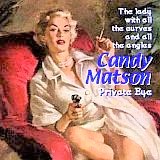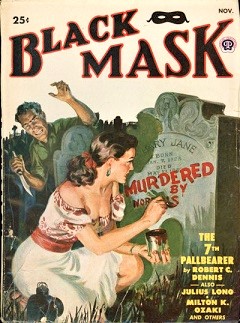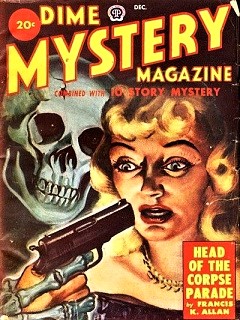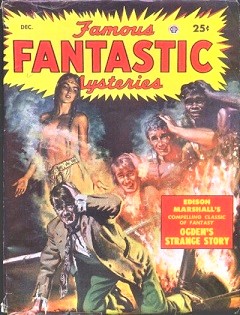
 Candy Matson (1949-1951) aired “Jack Frost” on December 10, 1949 (though some put the date as December 17) as the 25th of its estimated 93 shows (some accounts give 92 as the number). With Christmas but a few days away I thought I would present an Old Time Radio episode with a definite Christmas bent, not one which happened to be aired around Christmas, but with something to mark it as a holiday episode. I found a good one, one featuring a woman detective to boot, and a smart, self-sufficient one at that. Everyone is familiar with all of the police or detective shows featuring a male detective, sleuth, or investigator (some in the superhero vein). There was The Saint, Sherlock Holmes, Nick Carter, Sam Spade, Philip Marlowe, Nero Wolfe, Jeff Regan (starring Jack Webb), Dragnet (again starring Jack Webb), Johnny Dollar, The Green Hornet, The Shadow, and many, many others. One estimate runs to 120 OTR detective/police shows featuring a male lead. But not only were there Private Eyes on radio, there were Private Eyelashes as well, as early as the late 1930s and well into the 1940s (Kitty Keene, Carolyn Day-Detective, Miss Pinkerton, Meet Miss Sherlock, and Police Woman, to name a few). Though short lived (it never had a sponsor, advertisers were jumping on early television to promote their products), Candy Matson was one of the most popular radio shows west of the Mississipi and especially in San Francisco.
Candy Matson (1949-1951) aired “Jack Frost” on December 10, 1949 (though some put the date as December 17) as the 25th of its estimated 93 shows (some accounts give 92 as the number). With Christmas but a few days away I thought I would present an Old Time Radio episode with a definite Christmas bent, not one which happened to be aired around Christmas, but with something to mark it as a holiday episode. I found a good one, one featuring a woman detective to boot, and a smart, self-sufficient one at that. Everyone is familiar with all of the police or detective shows featuring a male detective, sleuth, or investigator (some in the superhero vein). There was The Saint, Sherlock Holmes, Nick Carter, Sam Spade, Philip Marlowe, Nero Wolfe, Jeff Regan (starring Jack Webb), Dragnet (again starring Jack Webb), Johnny Dollar, The Green Hornet, The Shadow, and many, many others. One estimate runs to 120 OTR detective/police shows featuring a male lead. But not only were there Private Eyes on radio, there were Private Eyelashes as well, as early as the late 1930s and well into the 1940s (Kitty Keene, Carolyn Day-Detective, Miss Pinkerton, Meet Miss Sherlock, and Police Woman, to name a few). Though short lived (it never had a sponsor, advertisers were jumping on early television to promote their products), Candy Matson was one of the most popular radio shows west of the Mississipi and especially in San Francisco.
We have showcased but two of the 14 surviving Candy Matson episodes, the first back in March of 2017, and the second this past August. For those not familiar with those widely spaced episodes and the show’s interesting history (a female detective, a veiled gay character, etc.), I am reprising below (with minor alterations) from the original introductory notes:
 Candy Matson was the brainchild of Monty Masters. Originally conceived as a private investigator program set in San Francisco with a male lead, Masters’ mother-in-law convinced him to feature a female private eye. Masters then turned to his wife Natalie Masters (the former Natalie Park, 1915-1986: photo at left, Monty and Natalie, May 1957) to play the lead role, for which her real life personality was made. Candy Matson lived life to its fullest. A former actress who gave it all up for the life of a private detective, she now resides in a penthouse atop San Francisco’s famed Telegraph Hill. Throughout various episodes we learn that she loves her furs, sunbathing on her patio, listening to 49ers football games while sipping martinis, and pretty much her overall luxurious lifestyle. She never compromises in deference to her sexuality, and is a much sought after investigator–as her high-end fees can attest. About her love of cash, Candy quips that it is needed to keep the “moths out of a few mink coats.” Candy had two recurring supporting characters in her adventures, handsome police Lieutenant Ray Mallard (with whom she has more than a professional relationship as the series progresses and as his character becomes more suave and alluring with each episode), and her best friend Rembrandt Watson, a single, middle-aged, flamboyant fashion photographer who enjoys the opera. Even though San Francisco had the largest gay community of any American city after World War II, and the show was set in the City by the Bay, network radio in the 40s and 50s would not allow an openly gay character to appear on the air, but Masters’s scripts managed to suggest as much, and the actor who played Watson, Jack Thomas (stage name for Natalie’s real life uncle), added a slightly feminine air to his characterization as time went on. After listening to several of the 14 extant episodes, it is easy to understand the popularity of Candy Matson. Natalie Masters plays her perfectly: saucy, sexy, smart, hard as nails when need be, and unapologetic and fully embracing her chosen lifestyle. A woman for the ages it would seem and ahead of her time. Natalie Masters would go on to have roles in several films and numerous episodes of popular tv shows, several of which are shown below.
Candy Matson was the brainchild of Monty Masters. Originally conceived as a private investigator program set in San Francisco with a male lead, Masters’ mother-in-law convinced him to feature a female private eye. Masters then turned to his wife Natalie Masters (the former Natalie Park, 1915-1986: photo at left, Monty and Natalie, May 1957) to play the lead role, for which her real life personality was made. Candy Matson lived life to its fullest. A former actress who gave it all up for the life of a private detective, she now resides in a penthouse atop San Francisco’s famed Telegraph Hill. Throughout various episodes we learn that she loves her furs, sunbathing on her patio, listening to 49ers football games while sipping martinis, and pretty much her overall luxurious lifestyle. She never compromises in deference to her sexuality, and is a much sought after investigator–as her high-end fees can attest. About her love of cash, Candy quips that it is needed to keep the “moths out of a few mink coats.” Candy had two recurring supporting characters in her adventures, handsome police Lieutenant Ray Mallard (with whom she has more than a professional relationship as the series progresses and as his character becomes more suave and alluring with each episode), and her best friend Rembrandt Watson, a single, middle-aged, flamboyant fashion photographer who enjoys the opera. Even though San Francisco had the largest gay community of any American city after World War II, and the show was set in the City by the Bay, network radio in the 40s and 50s would not allow an openly gay character to appear on the air, but Masters’s scripts managed to suggest as much, and the actor who played Watson, Jack Thomas (stage name for Natalie’s real life uncle), added a slightly feminine air to his characterization as time went on. After listening to several of the 14 extant episodes, it is easy to understand the popularity of Candy Matson. Natalie Masters plays her perfectly: saucy, sexy, smart, hard as nails when need be, and unapologetic and fully embracing her chosen lifestyle. A woman for the ages it would seem and ahead of her time. Natalie Masters would go on to have roles in several films and numerous episodes of popular tv shows, several of which are shown below.
(Left: Dragnet, 1957 – Center: My Three Sons, 1964 – Right: The Addams Family, 1966–with Parley Bear, the voice of Chester on radio’s Gunsmoke and later as Mayor Stoner on tv’s The Andy Griffith Show.)



 Dudley Manlove, the program’s announcer, is an enigma, for no one knows of his whereabouts or if he even still lives (doubtful). Little more is known of his wife, Patty Pritchard, though as of 2002 her voice could still be heard on a local San Francisco car dealer’s commercial. An interesting bit of trivia for genre fans is that Manlove played the alien named Eros from 1959’s Plan 9 from Outer Space (photo at left).
Dudley Manlove, the program’s announcer, is an enigma, for no one knows of his whereabouts or if he even still lives (doubtful). Little more is known of his wife, Patty Pritchard, though as of 2002 her voice could still be heard on a local San Francisco car dealer’s commercial. An interesting bit of trivia for genre fans is that Manlove played the alien named Eros from 1959’s Plan 9 from Outer Space (photo at left).
“Jack Frost” begins as the rather innocent story of a missing Santa Claus, one of those to be found in department stores or ringing a bell on street corners shortly before Christmas. When a friend of Candy’s seeks her aid in finding the missing Claus before his absence is known, the search quickly takes a dark turn and Candy finds herself in the middle of a very convoluted and dangerous plot. So listen now as Candy Matson, female private eye, tries to uncover the whereabouts of the missing Santa Claus who goes by the name of “Jack Frost.”
Merry Christmas/Happy Hanukkah/Happy Holidays to you all.
Play Time: 29:30
{December of 1949 saw the neighborhood miscreants again frequenting the local newsstand for their favorite reading. Bi-monthlies were on their lists this time, monthly regulars having been snatched on theor previous visit. In the mood for more mystery or detective fiction after listening to this week’s Candy Matson offering, the following magazines were purchased with some pre-Christmas money. Black Mask (1920-51) was the gold standard and watering hole for the major detective authors of the day. Dime Mystery Magazine (1932-50) sought a more colorful and often times bizarre kind of story, as reflected in the symbolic cover below. And Famous Fantastic Mysteries (1931-53) captured young imaginations with much more of a fantastic element to its strange mysteries, with eye-catching covers like the one here.}
[Left: Black Mask, Nov. 1949 – Center: Dime Mystery, Dec. 1949 – Right: Famous Fantastic Mysteries, Dec. 1949]



To view the entire list of weekly Old Time Radio episodes at Tangent Online, click here.